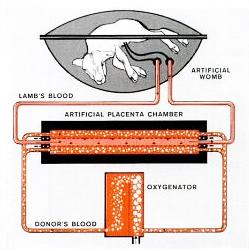Mr. Jean Fortin |
Such is the case with a donation the Museum received in 2010 from Mr. Jean Fortin, a retired marketing specialist in biomedical products. Mr. Fortin’s story intrigued me when he first contacted the Museum. He wanted to offer us a small collection of papers documenting his role in the early 1960s in the development of an artificial placenta at the University of Alberta. This project was led by Dr. John C. Callaghan, a cardiac surgeon at the university hospital noted for setting up the its open heart surgery unit in 1956 and performing the first successful cardiac operations in Canada using the heart-lung pump. He had previously worked in Toronto in the early 1950s with Dr. W.G. Bigelow to develop a first-generation intravenous pacemaker, an ancestor of modern day pacing.
I found Mr. Fortin’s role in this work interesting because he was one of the technicians involved in the artificial placenta project, an occupation often underreported in historical documentation of scientific and medical advances. Born in Quebec and originally trained in the 1950s as a Royal Canadian Navy electronic technician, Mr. Fortin joined Dr. Callaghan’s team at the University of Alberta research laboratories in 1962. By 1964, he was responsible for maintaining all of the electronic equipment for the artificial placenta project.
The placenta machine was designed to nurture a lamb removed by caesarean section from its mother. Before it could breathe on its own, it was placed in a plastic temperature-controlled bowl or artificial womb filled with a solution of sugar and salts replicating amniotic fluid. The lamb could be kept alive with a newly developed heart-lung machine that performed the oxygenating function of the placenta, the organ through which all unborn mammals receive oxygen and food from their mothers. Because they have similar physiological needs to human babies, lambs were often used during this period as stand-ins for humans in experiments.
The experiment’s main purpose was to devise ways to improve heart-lung machines that had already become standard in many hospitals. Although essential equipment for surgeons performing open heart surgery, existing heart-lung machines tended to damage blood cells after five or six hours of continuous use and therefore were used mainly for surgery and never as a life-saving aid for a baby born prematurely. Dr. Callaghan’s intention was to perfect a heart-lung machine that oxygenated blood so gently that premature babies with lung ailments could be kept alive until they were able to breathe on their own.
Mr. Fortin’s responsibilities including tending a flock of 200 ewes and one ram to provide the project with lambs, but more significantly, he was the technician who developed the artificial lung component of the artificial placenta unit. As he explained to me, that portion of the machine was missing until 1964 when he managed to adapt an artificial kidney design to act as a ‘lung’ oxygenator.
Image source: Life Magazine |
In August 1964 the research team had its first successful experiment when one lamb survived for 21 hours in the machine and lived when it was removed. Mr. Fortin reports this lamb was named John Glenn after the first American astronaut to orbit the earth. The project received national coverage in that month’s edition of Life magazine (which also featured a cover story on the Beatles).
Mr. Fortin later became a regular member of the university hospital’s cardiac perfusion team running the heart-lung pump during open heart surgeries. By 1966 he had assisted in 500 operations. He told me of one dramatic incident during an open heart operation when the pump that provided the oxygenated arterial blood seized five minutes into the operation. Mr. Fortin was called out to operate the machine manually by turning a crank for 90 minutes until the surgery was completed. The patient survived.
Mr. Fortin later left the university to go into sales of cardiac monitoring equipment. He retired in 2005. We are grateful to Mr. Fortin for bringing this personal story of health care history in Canada to the Museum.
Paul Robertson
Note: After seven years with the Museum of Health Care Paul Robertson has decided to move on. The Museum of Health Care thanks Paul for his many years of innovative, exciting curatorial work and wishes him all the best in his new position. Although this will be Paul’s final blog post for Ex Crypta, the blog may continue in the future… stay tuned!




Hi there. Nice blog. You have shared useful information. Keep up the good work! This blog is really interesting and gives good details. suction unit portable, medical suction equipment.
ReplyDeleteGood to read this.
ReplyDelete